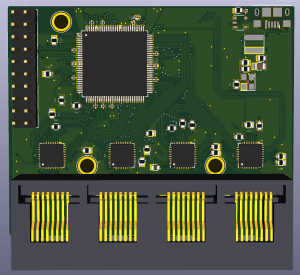The CrowdSwitch is the cornerstone of our efforts to bring IsoGrid to the world.
 |
 |
The CrowdSwitch is a hardware product in development. It is the first concrete implementation of the IsoGrid protocol stack. When connected together, the switches form a streaming, scalable, mesh network.
Our initial plan is to give low cost (or free) CrowdSwitches to people living in extremely high-density urban communities, who otherwise don’t have access to networks. One idea is to build it within a 501(c)(3) organization to make our altruistic motives super clear. Perhaps similar to the Mozilla model. Given that the funding model isn’t clear, another option could be a benefit corporation.
The CrowdSwitch is:
- 4-port auto-configuring switch
- 3x RJ45 ~100 Mbps full-duplex ethernet PHY with 1ms worst-case switching latency
- 1x RJ45 Ethernet connection to an external controller PC or SoC with 8ms worst-case switching latency
- 1x xSYS (JTAG) header
- Powered by Micro USB
- The core of the switch is an xCORE-200 XL216-512-TQ128
- Target (bulk) BOM cost is ~$15
- External controller PC/SoC (~$9) needs:
- Ethernet, ~512MB of RAM, ~16GB of flash, ability to create a wireless hotspot
The Wi-Fi on the PC/SoC will be able to work in one of two modes:
1. Providing Internet access to a user
2. Connecting to a regular Wi-Fi Internet access point
The IsoGrid formed by the interconnected mesh of CrowdSwitches provides a redundant multi-path backbone to connect nodes operating in Mode #1 to nodes operating in Mode #2.
Production Plan and Status
We want to give tons of these CrowdSwitch devices away or even sell them at a loss, so obviously, we’re going to be extremely price-sensitive. We negotiate with part suppliers directly to get the best price.
The first basic prototype built with the xCORE-200 SliceKit was validated in February 2018. Once the basic prototype was proven, we began building a series of small batches of prototype boards (100 total). Our first batch of 5 had significant issues, and were only partially functional. The next 10 are somewhat functional, and are being used to complete more of the software stack. Our manufacturing partner is Seeed Studio.
The SW stack proved to be much more difficult to make stable and useful. Much SW work was completed in 2019-2021. We’re working to ensure ethical use and a sustainable non-profit model to bring this to market.
Once we have proven out our HW and SW design, we’ll go into larger production. We’re considering starting a KickStarter where the proceeds from buying one for yourself would go to buying one for charity. We’re also considering applying for grants from other organizations with similar charitable goals. However, Travis and Lindsey are prepared to risk buy up to 1024 units using their own donated money in order to bootstrap the first IsoGrid meshnet in Dharavi (Mumbai), India. We plan to solicit donations directly from the public as soon as we have a product that is ready to scale up.
We plan to enforce trademark rights over “IsoGrid Foundation” and “CrowdSwitch”. We plan to use these brands as a mark of trust for buying quality hardware and software updates. For example, we could charge $0.05 to deliver a software update to deployed CrowdSwitch units. The price is low enough that it isn’t likely to inspire for-profit competition.
